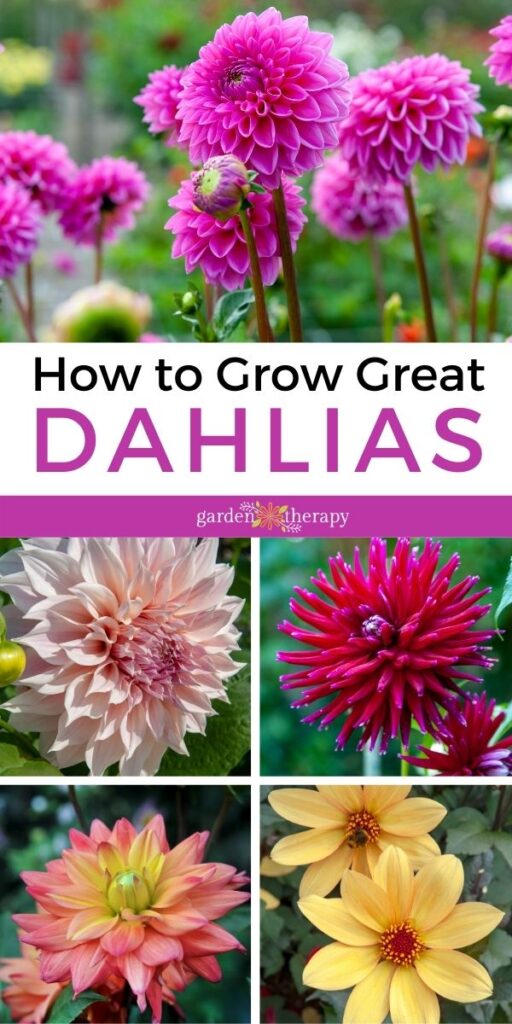Showy and stunning, dahlias are a summer flower that deserves to be in every garden! Luckily, it is quite easy to grow dahlias from a tuber. Learn how to grow and care for dahlias so you can have a showstopping garden this summer.
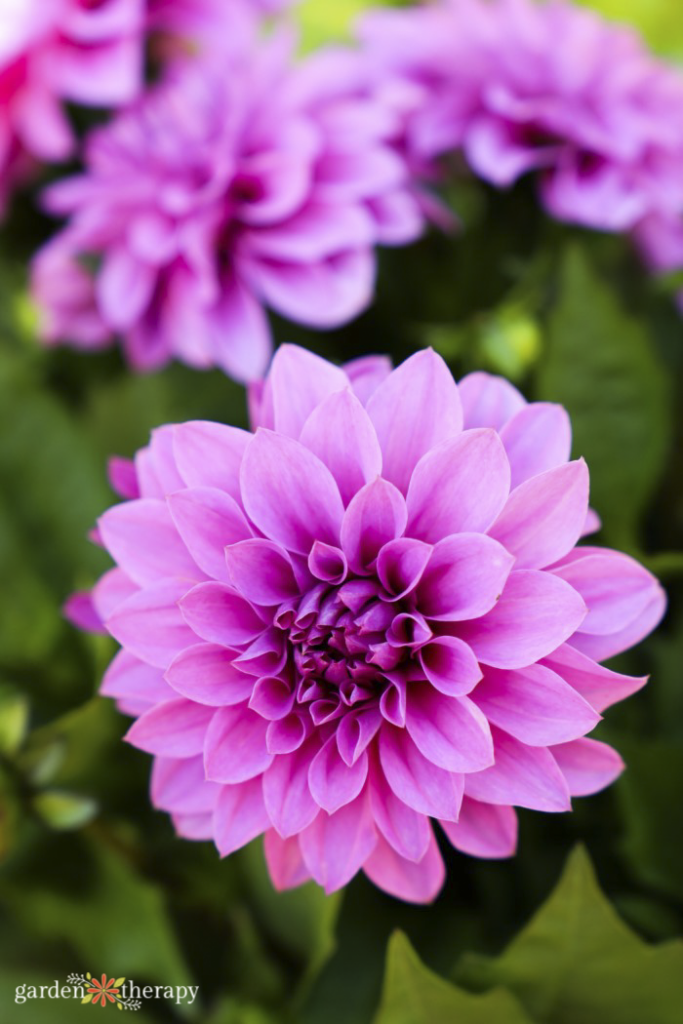
With tens of thousands of varieties throughout the world, there is a dahlia flower in practically every size. I’m talking about tiny, bushy dahlias the size of a ping-pong ball to full-sized flowers as big as soccer balls.
They also come in every colour under the rainbow—there’s even a striking black variety floating around. No matter which dahlia you choose, it’s sure to make an impact in the garden.
Originally from Mexico, dahlias are tropical flowers that grow in the summer from August to fall. Butterflies adore them, I adore them, and you likely adore them too. Let’s all grow dahlias so we can have the brightest coloured gardens on the block!
This post will cover…
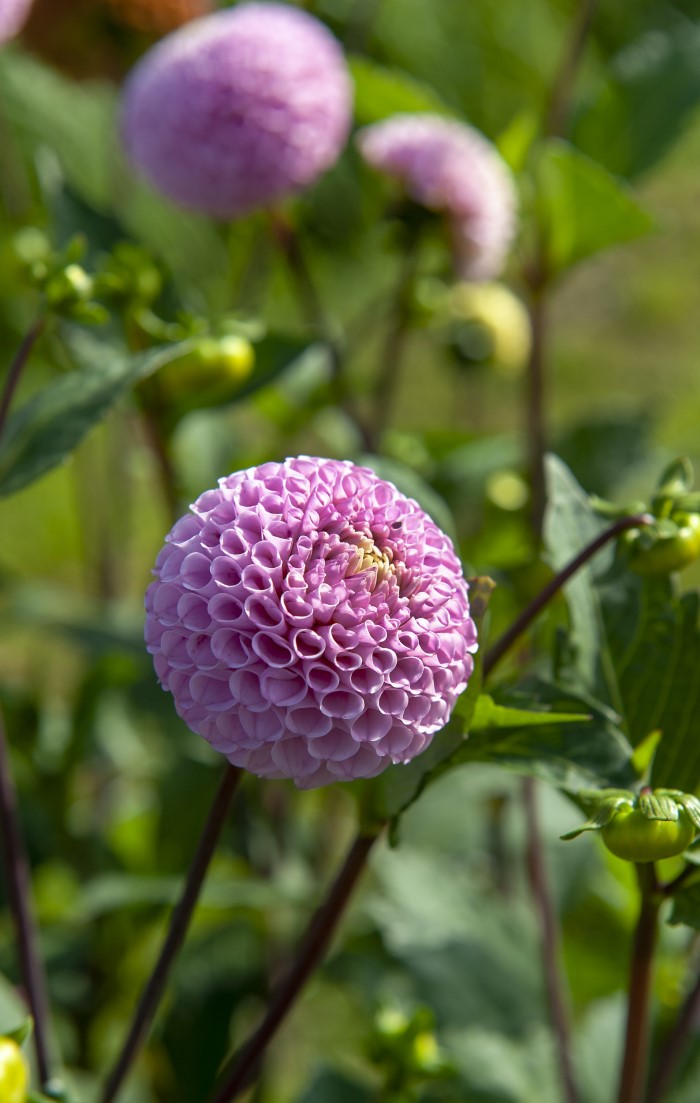
Photo credit: Thank you to Flowerbulbs.com for providing me with the gorgeous photos in this post and the descriptions of each type of dahlia.
The 12 Types of Dahlias
With so many shapes, sizes, and colours to choose from, there are a ton of dahlia flowers out there. Here are some of the main dahlia plants you can expect to find.
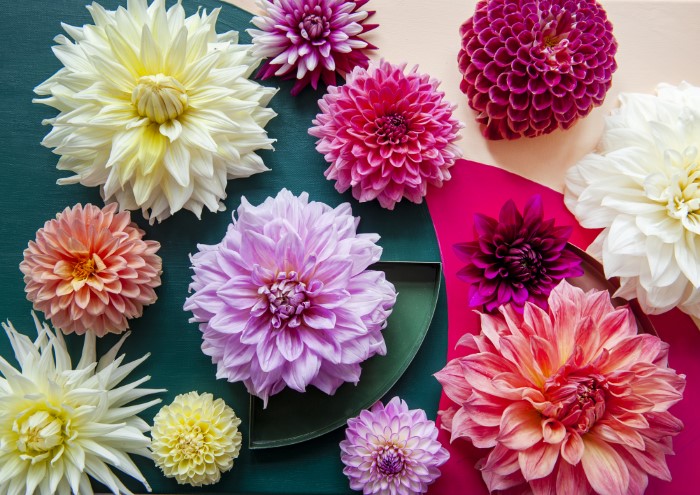
- Single-flowered: a single row of flat or cupped florets with a central disc. 12-24 inches tall.
- Anemone-flowered: a large outer ring of flat petals with a mass of tubular florets in the center. 24-36 inches tall.
- Collarette: a large outer layer of flat petals with an inner wreath of collar-like florets. 30-48 inches tall.
- Waterlily: full double blooms in a flattened shape. Up to 48 inches tall.
- Decorative: known for having large and bushy blooms. Popular for cut flowers.
- Ball: small globe-like variety with double blooms. Flat florets that are blunt or round-tipped. 48 inches tall.
- Pompon: another small, globe-like variety with double blooms. Florets are curled and blunt or round-tipped. 32-48 inches tall.
- Cactus: double flowers with long, pointed petals. 60 inches tall.
- Semi-Cactus: another double flower with long pointed petals, but the petals curl for half or less of their length. 60 inches tall.
- Peony-flowered: open-centered flower with two or more rows or rounded petals. 40 inches tall.
- Mignon: small variety with a single layer of rounded florets 1-3 inches long. Well suited for containers. 20 inches tall.
- Topmix: another small variety of single-flowers. Quite bushy and well suited for containers. 14 inches tall.
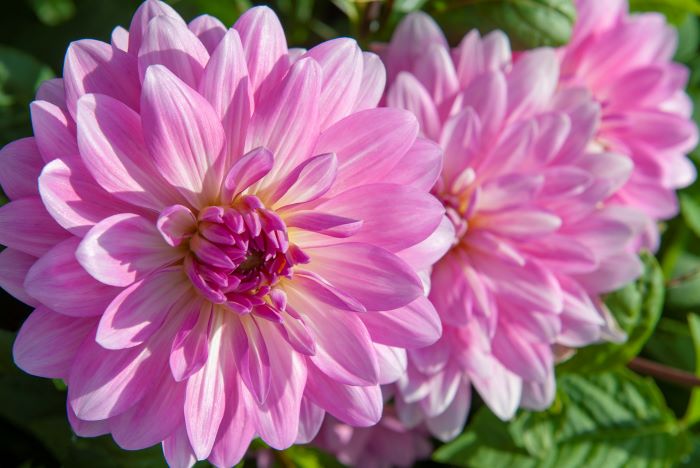
When to Plant Dahlias
Dahlias are a summer blooming flower that should be planted in the spring after the risk of frost has passed. They like warm soil, so I usually like to wait another month and a bit after our last frost to put them in the ground.
If you want a head start, you start them indoors before placing them outside.

I shared this video as part of the Random Gifts of Flowers project I worked on with Flowerbulbs.com. The project and video were made in partnership with Flowerbulbs.com, but this post is not sponsored.
How to Plant Dahlia Tubers
While dahlia seeds do exist, they are quite tedious and difficult to grow. Instead, most folks grow dahlias from tubers. Dahlias are not hard to grow, but they can’t handle freezing temperatures in the winter. In colder climates, they are either treated as annuals or dug up and stored for the winter.
Only plant dahlias when you’re 100% sure the risk of frost has passed. In most areas, you can plant dahlias around mid-May. Get a head start by planting them in pots in a greenhouse or indoors.
Plant the tuber so that the tip of the old stem is pointed upward. If you have a single tuber, as opposed to a cluster, lay the tuber down so that the tuber “eye” is pointed up. This looks like a small bump on the neck of the tuber (see the photo below to help identify the tuber eye). This is where the stem will grow from.
Place tubers no deeper than two inches underground. Cover the dahlia tuber with soil and press down lightly. After planting, thoroughly water the area. Avoid watering again until after the dahlia seedling has emerged so the tuber doesn’t rot, unless the ground become bone dry again.
Dahlias need full sun, including at least a couple of hours of the morning sun. The tubers are planted just below the surface so that they’re warmed by the sun’s heat and begin growing ASAP.
Dahlia flowers work well as border plants due to their long flowering period. In full sun, they have strong stalks and act as a garden feature. The taller varieties can line the back border, while shorter varieties can be planted in the beds or in the front border.
Be sure to pay attention to the variety and height on the packets when planting because moving when they are blooming can cause them too much stress, making them flop and reducing blooms.
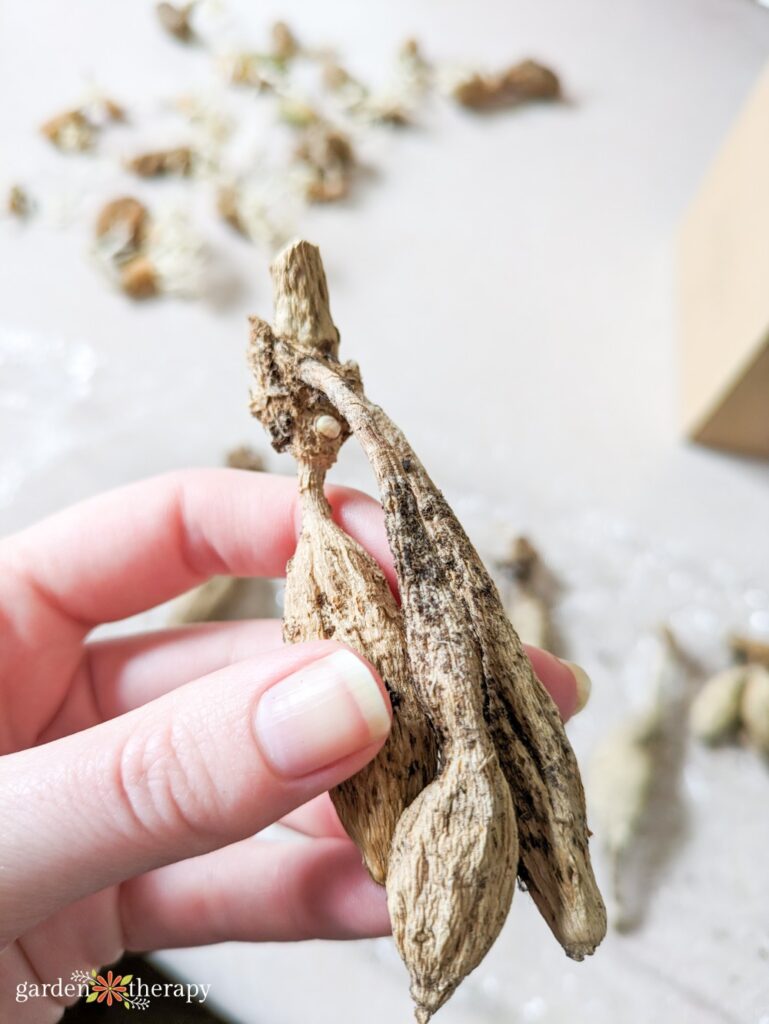
Dahlia Plant Care
Once you’ve planted your dahlia tubers, you can expect shoots to emerge 1-2 weeks later. Give your shoots 4-6 more weeks (depending on the type of dahlia), and you will get your first flowers. Typically, this is the beginning of August.
If you pinch out the main stem approximately 3 weeks after planting, you will be rewarded with a bushier plant.
Water your dahlias if the weather has been fairly dry. In the event of heavy rain and wind, you may need a stake to support tall dahlia varieties.
Deadheading will be your key to more blooms. Dahlias will continuously bloom as long as you make an effort to remove any spent flowers.
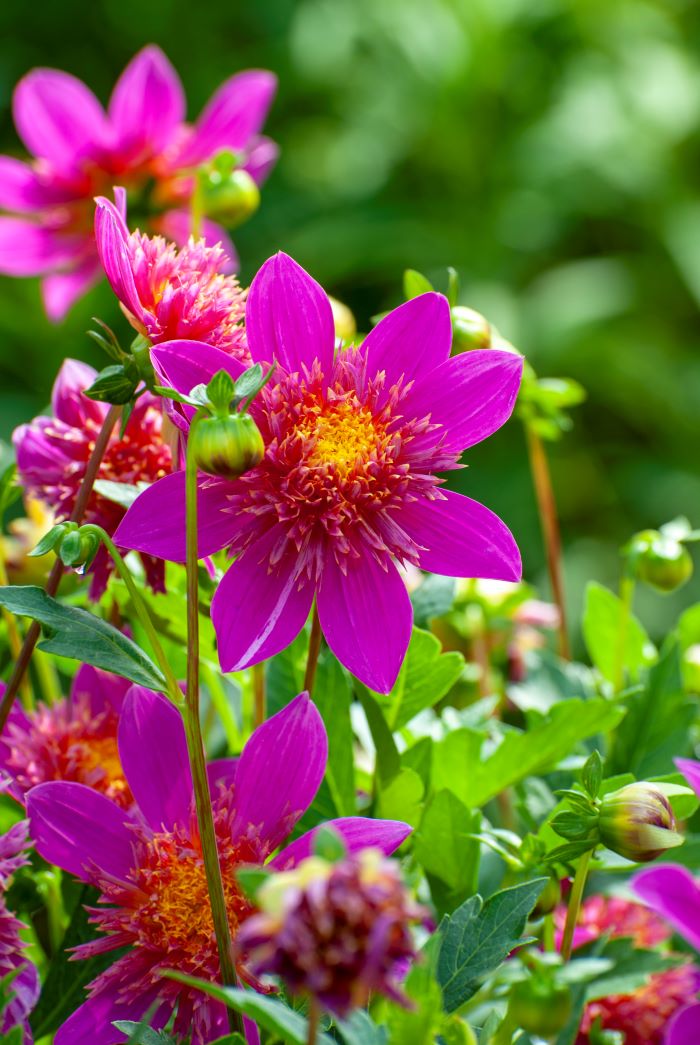
Can You Leave Dahlias in the Ground in the Winter?
For many of us, unfortunately, the answer is no. Since they are tropical plants, dahlias are only considered perennial and winter hardy in US zones 8 or above.
For the rest of us, we can dig up our dahlia tubers before the first frost. Store tubers in a cool yet frost-free place for the winter. Come spring, you plant them again once the fear of frost has passed.
For more on how to save your dahlia tubers, check out this post.

Force Start Dahlia Flowers Indoors
A well-known tip is to force start summer bulbs indoors in order to get blooms earlier. Just like seed-starting, you can plant tubers indoors at the end of March to mid-April. Plant them in a pot the same way you would outside.
Be sure not to overwater dahlia tubers in pots, as they can be prone to rotting. I like to pre-moisten my soil, and that’s all the moisture my dahlias need to start growing. If after a week I don’t see sprouts, I’ll water the soil again and repeat when the soil becomes dry.
Once the risk of frost has passed and the soil has warmed up a bit (mid-May here in Vancouver) place your pot outdoors to get your dahlia plant used to the conditions. After a week, plant your dahlia in the ground.
This means you will have flowers a month earlier than if you planted the tubers directly in the ground. You can expect blooms at the beginning of July. Plus, you won’t have any snails who like to munch on the young, crunchy dahlia leaves.
My gardening pal, Erin over at The Impatient Gardener, has a great video on how to pull dahlias out of winter storage and pot them for an early start. She is a bit of a dahlia addict (Sorry, Erin, it had to be said), so if you love dahlias, be sure to follow her on YouTube and Instagram.

Growing Dahlias in Pots
Dahlias make for a gorgeous container flower. If you don’t have a garden but instead have a balcony or patio, you can still grow these gorgeous flowers.
The key to growing dahlias in pots is choosing the right variety. Dwarf varieties work well in pots, including Mignon, Topmix, Dahlietta, Dahlstar, Dahlinova, and Gallery dahlias. Alternatively, you can include tall dahlias as a centerpiece for larger containers.
If you plant dahlias in a container, choose a pot with drainage holes in the bottom and lower sides. Adding a layer of clay granules to the bottom of the pot also helps to increase aeration for the roots. Plant with good potting soil, and then you’re good to go.

FAQ About Growing Dahlias
Due to their popularity, dahlia tubers are very easy to find. You can find them with most flowering bulbs for sale in the spring at your local garden centre or hardware store. Online, Breck’s Bulbs is a great supplier, as is West Coast Seeds.
For specialty tubers, look up your local dahlia or horticultural society. They may be hosting a plant sale where dahlia tubers will be sold. Many flower farmers will also sell dahlia tubers in the spring, so feel free to message those in your local area.
One dahlia tuber planted in the spring can become a cluster by the end of the growing season. When done right, you can carefully separate the tubers and successfully double the number of dahlias you’ll have next year.
In order for a tuber to be successful and produce a plant, it needs to have three things: a body, an eye, and a neck. The body is the main rounded part of the tuber, and it should be in good health. A neck is the skinny part at the top that connects to the main stem. And finally, an eye is a small bump located on the neck of the tuber—it looks like a freckle or even a pimple (see picture under “how to plant dahlia tubers”).
Cut your dahlia flowers in the morning after the dew has dried—this is when the plant is hydrated and not stressed. Dahlias won’t open much after they are cut, so you want to cut them when they’re almost fully open yet not overly ripe. Any papery leaves are a sign of age. They should last 5-7 days once cut.
If you can’t get enough of dahlia flowers, I highly recommend Floret Farm’s Discovering Dahlias by Erin Benzakein. It is a full guide all about growing and arranging dahlias and is a must-have book for any serious dahlia growers.
What type of dahlia is your favourite to grow? Let me know in the comments down below which dahlia you plan to plant using this guide.
More Tips for Growing Flowers
A city girl who learned to garden and it changed everything. Author, artist, Master Gardener. Better living through plants.

